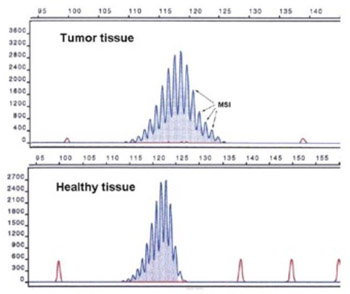Microsatellite Instability and Loss of Heterozygosity of Tumor Suppressor Genes in Bosnian Patients with Sporadic Colorectal Cancer
DOI:
https://doi.org/10.17305/bjbms.2008.2883Keywords:
microsatellite instability, RER phenotype, sporadic colorectal cancer, loss of heterozygosityAbstract
Considering its frequency, high mortality rate as well as many etiological mysteries colorectal cancer is a challenge to contemporary science. In our study we analyzed RER + and RER - phenotypes and their relations with clinical-pathological characteristics of sporadic colorectal cancers. We also analyzed genetic alterations of tumor suppressor genes as well as their relation with microsatellite instability. The study was based on 54 tumor samples and 54 samples of the surrounding healthy tissue of patients with colorectal cancer. According to Amsterdam Criteria and Bethesda Criteria 35/54 or 64,81% belonged in the group of sporadic colorectal cancer. Mononucleotide marker Bat 25 showed instability in 48,57%; Bat 26 in 45,71% and Bat 40 in 29/35 82,86% of tumor samples. Considering dinucleotide markers, TP 53 showed instability in 54,29% and DS123 in 37,14% of tumor samples. Genetic alterations in tumor suppressor genes were found in tumor tissue: NM 23 in 54,29% samples, p53 in 51,43%, APC in 51,43%, DCC2 in 34,29%, RB1 in 22, 86% and DCC 1 in 28,57%. Our studies confirmed that genetic instability had an important role in the development of tumor type. Our results showed that mononucleotide marker Bat 40 might be used for an easy and fast screening procedure in Bosnian population, because it exhibited high percent of microsatellite instability and was in relation with RER+ phenotype. This investigation showed that different genetic alterations may occur during cancer development in each individual patient’s tumor. These changes result in MMR inactivation, which causes RER+ phenotype. Our results suggest a connection between alteration in some tumor suppressor genes and MSI phenotype of sporadic colorectal cancer in Bosnian population.
Citations
Downloads

Downloads
Published
Issue
Section
Categories
How to Cite
Accepted 2017-12-26
Published 2008-11-20









